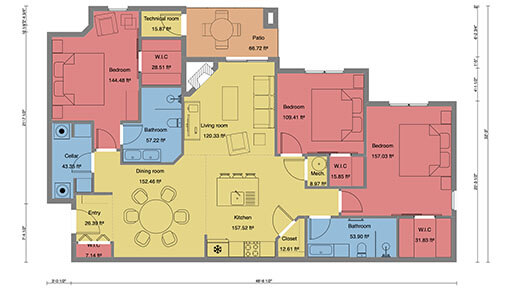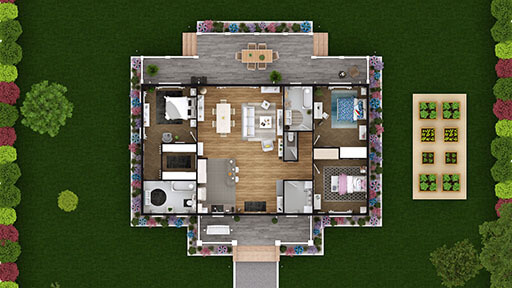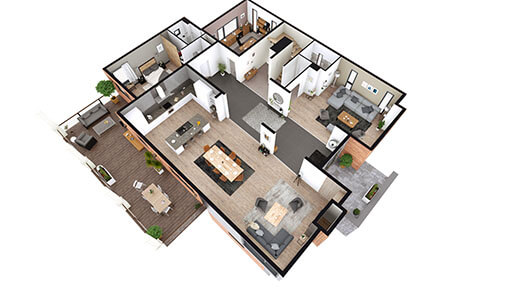Residential design and construction are booming. In the United States alone, nearly 978,000 residential building permits for single-family homes were issued in 2020. Compare that to just over 640,000 permits issued in 2014, and you can see that this is a great time to be a residential home designer or home builder. And the story is the same in many parts of the world.
But to do residential designs, you have to acquire a solid understanding of the architectural design phases. In other words, you need to understand how to turn a blank page into a beautiful residential home. Read on to learn everything you need to know.
What is Residential Design?
Residential design is a fancy way of saying home design. However, this field does not only involve freestanding, single-family homes you might see in a suburban neighborhood. It covers nearly any structure that might become a place where people live.
That means apartments, townhomes, mansions, cottages, cabins, condos, duplexes, and more are all considered residential building designs. Every one of these non-commercial structures you see in your city has a residential home designer like you behind it — someone who took the building’s concept through all of the architectural design phases.
How Long is the Residential Design Process?
Residential designs take some time to complete, but how long they take depends on a variety of factors. In general, the design process — from concept to client approval — takes somewhere between four and six months. However, using high-quality home design software and other helpful tools can shorten the timeline considerably.
7 Phases of Residential Design
The residential design process breaks down into seven key phases, each of which is essential to the eventual finished product. Below, we explore each of these phases in depth.
Phase #1. Pre-design
Pre-design is everything that happens before you actually put pen to paper for residence design concepts. The actual design phases are perhaps the most exciting, but pre-design is one of the most essential architectural design phases because it sets the stage for a stunning home.
What’s involved:
- The developer and property owner establish a project budget that you will need to adhere to.
- A site analysis examines the property for construction feasibility and potential issues.
- Project team members conduct a code and zoning analysis to identify what can legally and safely be built on the property.
- All parties work to establish an acceptable project timeline and scope of work.
- The project team is selected.
Phase #2. Schematic design
In the schematic design phase for residential properties, the designer and property owner work together to design what amounts to the bare bones of the home. The client provides a list of what kinds of basic rooms and features the structure should contain, and the home builder determines how and where these items will be presented.
The tangible product that comes from this residential design phase is a schematic — or rough outline — of the home to be designed. In the past, residential home designers completed the schematic on physical media like drafting paper. But that presented some problems.
Specifically, the schematic design phase should involve a lot of back and forth between the designer and the client. If the schematic design is on paper, each point of feedback requires the designer to create a completely new schematic. Residential design software like Cedreo has simplified and sped up that process. Cedreo allows designers to quickly update designs based on feedback from clients, reducing the number of hours spent at the drafting table.
What’s involved:
- The designer works with the client to understand the basic features of the structure.
- The designer develops the ideas for the basic floor plan and exterior design of the home.
- The client and designer go back and forth on the schematic, offering and implementing points of feedback until the client approves.
Phase #3. Design development
A lot happens in the design development phase of residential design. This is where the home you are designing starts to come to life. The most important result of this phase is the 2D floor plan of the home. This floor plan will showcase both the interior and exterior walls, as well as the products, materials, and finishes to be used in many areas of the home, such as the windows, walls, doors, and floors.
While all of that is happening, an engineer begins work on the designs for the home’s plumbing, electrical and similar systems.
At the end of this phase, the client and designer should have agreed on most of the major points of interest in the home’s design and have in hand a 2D floor plan that will set the stage for the rest of the residential design project.
What’s involved:
- The designer completes the basic 2D floor plan and seeks client approval.
- The client offers feedback on the 2D floor plan, and the designer incorporates that feedback.
- Engineers begin working on the HVAC, electrical, and plumbing systems within the home design.


Phase #4. Construction drawings
At the end of Phase #3, the basic 2D floor plan is complete, but residential building designs require a lot more detail than what this basic floor plan will provide. This is the phase where you add that extra detail.
In this phase, the designer and various other project team members finalize their designs down to the last detail. The result is a set of construction drawings that contain enough detail for the actual construction of the design to begin.


Plumbing, heating, cooling, and electrical system layouts are finalized; all products and building materials are sourced and selected, and drawings from multiple angles of the design include technical markup and documentation.
What’s involved:
- All products and materials to be used in the home’s construction are selected.
- The layouts for plumbing, electrical, heating, and similar systems within the home are finalized.
- The designer completes a set of construction drawings that contain enough detail to facilitate construction.
Phase #5. Building permitting
The construction documents completed in the previous phase undergo a final addition for the building permitting phase. The project team adds to these documents any information local permitting authorities will need to approve the permit for the project.
That may sound simple, but this phase of the residential design process can take months to complete if there are any roadblocks. Some common issues home builders may need to contend with include dealing with community design review standards and the requirements of historic districts the property may be included in.
What’s involved:
- The project team adds technical documentation to the construction documents to show permitting authorities that the structure complies with zoning and land use regulations.
- Forms for the permit application are completed and submitted.
- Any changes required for approval are implemented.
Phase #6. Bidding and negotiation
After the proper permits are issued, the bidding and negotiation process begins. This is where contractors bid for parts of the project with a proposed budget and the home builder interacts with them to make sure the bid would fall within the project’s budget. That interaction may involve suggesting alternative materials or construction methods.
The home builder will also walk the property owner through the contractor bids that come in so that they understand the pros and cons of each and can make a final decision.
What’s involved:
- A request for bids is released, and contractors submit bids.
- The designer and other team members work with bidders to refine bids and budgets.
- Winning bids are chosen.
Phase #7. Construction
The final stage of the residential design process involves little to no actual design. This is when construction of the home begins — the design part is over.
However, the designer will still be involved as the home comes together. They may visit the construction site at specific times to answer questions and ensure that the construction is reflective of the design. When construction is more or less complete, the designer may then do a final inspection of the home to create a to-do list that will make the final product fully resemble the approved design.
What’s involved:
- Construction of the home begins.
- The architect visits the construction site to solve problems and answer questions.
- Construction is completed.
- The designer does a final walkthrough to identify any remaining issues.
Streamline the Residential Design Process
What is residential design? It’s the essential process of conceptualizing a residential structure and then making it a reality. Residential building designs require a lot of work, but when they are broken down into the key architectural design phases, they become a simplified, scalable process.
To further simplify and scale your residential design business, consider adding technology like Cedreo to your toolbox. Our home building software allows home builders to quickly create schematics, 2D designs, 3D floor plans, and photorealistic, furnished designs that help clients visualize the final product. That translates to a faster process, happier clients, and more business.
Ready to give it a shot? Try Cedreo for free.



